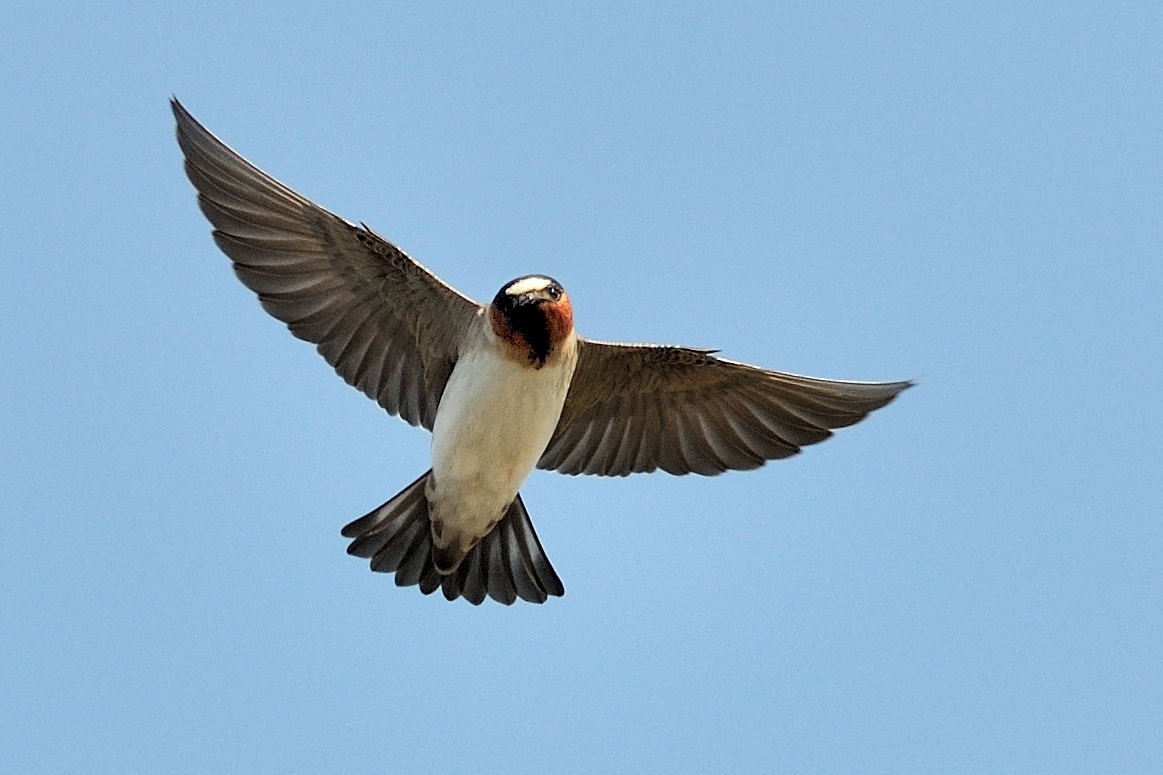Cliff Swallow
A species of Cliff Swallows and Allies, Also known as Mud Swallow Scientific name : Petrochelidon pyrrhonota Genus : Cliff Swallows and Allies
Cliff Swallow, A species of Cliff Swallows and Allies
Also known as:
Mud Swallow
Botanical name: Petrochelidon pyrrhonota
Genus: Cliff Swallows and Allies
Content
Description People often ask General Info
 Photo By Don DeBold , used under CC-BY-SA-2.0 /Cropped and compressed from original
Photo By Don DeBold , used under CC-BY-SA-2.0 /Cropped and compressed from original Description
The cliff Swallow is a small, compact swallow that can be found in open areas of farms and towns, although it once exclusively inhabited natural rocky habitats in mountainous regions. An extremely sociable bird, it nests in large colonies that count for several thousand nests at one site. The cliff Swallow is able to catch an insect in flight and it migrates in large flocks.
Size
14 cm (5.5 in)
Life Expectancy
12 years
Nest Placement
Cliff
Clutch Size
1 - 6 eggs
Incubation Period
1 - 2 broods
Number of Broods
10 - 19 days
Nestling Period
20 - 26 days
Feeding Habits
Cliff Swallow consumes various flying insects and forages primarily in groups. They capture food mid-air above open and diverse landscapes, also utilizing thermal currents to locate insect swarms. Cliff Swallow's diet includes bugs, bees, wasps, ants, beetles, mayflies, and more. Weather influences their foraging areas, with adverse conditions leading them to water bodies. Additionally, cliff Swallow colonies share foraging information, with unsuccessful individuals following successful ones.
Habitat
Cliff Swallow are found in diverse habitats, including open canyons, foothills, and escarpments. Preferring areas close to water sources, they have adapted to urban environments, nesting on man-made structures in towns, grasslands, and agricultural areas. Originally nesting on natural cliff faces, they now also inhabit river valleys, riparian edges, and savannahs. They avoid heavy forests and deserts and are rare in south-central and northeastern states. Cliff Swallow breed near fields and pastures, and during winter, migrate to South American grasslands and farmlands.
Nest Behavior
Cliff Swallow's nest building is a cooperative task, with males initiating construction. They use mud from nearby water bodies, forming pellets transported by bill. After choosing a colony site, nest construction and mating ensue, followed by continuous nest maintenance and grass lining. Both parents care for their clutch, which exhibits variable egg-laying patterns.
Nest Characteristics
Cliff Swallow constructs nests at the juncture of vertical walls and horizontal overhangs, commonly on cliffsides, under bridges or in buildings. The gourd-shaped mud nests are around 8 inches long, 6 inches wide, and 4.5 inches high, with 0.2–0.7-inch-thick walls, crafted from 900–1,200 mud pellets. The entrance, often tube-like, measures about 1.7 inches by 2 inches, lined with dried grass.
Dite type
Insectivorous
People often ask
General Info
Feeding Habits
Bird food type
Bird Feeder Type

Platform
Sounds
Call
Recording location: United States
Call
Recording location: United States
Song
Recording location: United States
Behavior
Cliff Swallow are highly social, often forming vast colonies with hundreds to thousands of nests for breeding. These birds engage in communal activities, such as preening, feeding, and bathing. They also exhibit strong fidelity to their group throughout migration and wintering. For roosting, cliff Swallow prefer trees, though during breeding season, they may sleep in their nests. They are known for vigorous competition for nesting sites, at times even grappling and risking falls into water. To protect completed nests, cliff Swallow use visual puffing displays and aggression. Breeding pairs are monogamous within the nest but display extra-pair mating behaviors. They face predation from various bird species, snakes, and mammals, underscoring their importance in the ecosystem's food web.
Distribution Area
As their name suggests, throughout history the American cliff swallows concentrated their nesting colonies along mountain cliffs, primarily by the Western North American Coast. Today, with the development of highways, concrete bridges and buildings this adaptable bird species is rapidly adjusting their common nesting sites, with populations expanding further east and building their mud nests on these concrete infrastructures. Thus, the American cliff swallow's breeding range includes a large areas across Canada and the United States of America, excluding some Southern and Northern areas. The majority of nesting colonies are situated in close proximity to fields, ponds and other ecosystems that would hold a large variety of flying insect populations to sustain their energy requirements during the breeding season. The cliff swallows' wintering grounds have been recorded as South American countries, such as Southern Brazil, Uruguay, and parts of Argentina. However, their behavior and populations have yet to be extensively studied on their wintering grounds leaving room for new information about this species. The American cliff swallows are long-distance day-migrants that generally travel along the North American coast lines. The Eastern populations travel through Florida, and the Western populations through Mexico and Central America down to their destinations. Flocks containing large numbers of cliff swallows have been recorded migrating together, but whether they stay together or disperse to different locations is unknown. 
Species Status
Not globally threatened.